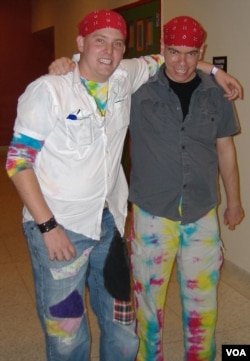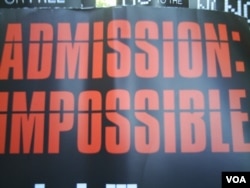Student Union
I Am On My Way....To Graduate School!
What then?
Well, in truth, I have known for a while now which path I wanted to pursue. I have been interested in politics and international affairs for a long time and would like to be a part of that world, whether in terms of policy and decision-making or analysis and commentary. So it wasn’t too hard for me to decide to look for master’s programs in that field. I know politics can be a real pain – both for the politician as well as the citizen – but it’s the one sphere, I feel, where I can achieve a meaningful impact.
As far as research into institutions went, the APSIA website (Association of Professional Schools of International Affairs) was a good place to start. I can’t say I did much beyond that, as that website listed many top institutions. I did also have a look at Ivy League colleges, and – I must confess, even though this is a blog of international students in America – that I looked at options in other countries as well.
GRE and TOEFL
One of the earliest steps in the process involved that peculiar practice in the U.S. of taking standardized tests and exams. I don’t want to be one to complain, but the truth is that the purpose (and definitely the price) of the GRE did not make much sense to me. I managed to take it over the summer in Armenia, though, before senior year, so at least I did not have to spend any time on it during the school year.
Proving English-language capability was fortunately not an issue for me, as my undergraduate studies are in English.
Application Process
Most of the universities where I applied had an almost-exclusively online admissions process. In fact, most of them had outsourced to the same company or software, so the way their websites were setup was similar. But I learned a great deal about the universities just by the admissions process itself, especially looking at what kind of questions those various places asked, what kind of demands they put on their applicants.
It seemed to me that some universities wanted extra reassurances from their applicants that they would be able to pay for their studies. Not that any university did not want such guarantees, but pushing that question was a bit of a turnoff for me.
Contrary to that, only one out of the six places where I applied asked for writing samples. That was really cool. They were also the ones who had real, live human beings respond to my e-mail inquiries within a matter of days. It’s little things like that which leave a lasting, positive impact.
Letters of Recommendation
The letters of recommendation are also a very important aspect of applications. People tend to be busy, so it is useful to remind your recommenders every once in a while to go on to that website and to submit that letter. I found a gentle reminder e-mail once every couple of weeks or so was enough. It is also a good idea to get an early start on your recommenders, so that they have the time to craft a meaningful letter.
I was fortunate in picking a couple of people at my college who I knew shared my interests and also with whom I had had helpful interactions over the past few years, including discussions on politics and international affairs. My third recommender was a mentor and internship boss of mine back in Armenia, so she had seen my “real life” work (as opposed to my academic work) and could speak to that.
If you are graduating soon, but if you won’t be applying for further study this coming year, I’d recommend asking a favorite professor to have a letter of recommendation on file, just as a reference in case of future need, because your professor may not remember as many details about your conduct in class or your character after a year or two.
Financial Aid
Even though the online applications were really similar, many of the universities to which I applied had entirely separate processes for financial aid, which required almost just as much work as the application itself.
I was told that it is difficult to get funding at the graduate level in humanities or social sciences, and, yes, as it turns out, the financial aid has not come to much, at least not as much as the support I'm receiving now for college. Still, every little bit helps, and I am grateful for the assistance.
Personal Statement
I like to think that the personal statement is the most important part of the admissions packet, so I worked really hard to highlight my strong points and to elaborate on why the place where I was applying was suitable for my choice of career and academic interest.
But I tried to be concise as well, as I imagine those universities get thousands and thousands of applicants with only a handful of staff to sort through them. They all put word limits, as a matter of fact, so the choice of words had to be careful too.
Different Paths
I have noticed that many of my fellow-seniors are not sure what path they wish to pursue. A lot will not be going on to graduate school. This seems to be a pretty normal thing around here. Work experience, internships, volunteer work or international experiences are a big plus, in fact, when applying to master’s programs. But I’d had all that before I came to the States, “in-between-schools,” as the saying would go. Since I already had a good idea of my choice of career, taking on this next challenge seemed like the right thing to do.
And that is very significant: to be aware of what it is exactly you want to do with your life. Finding the exact place or program that fits those aspirations comes second. There is an immense diversity of colleges and universities in this country, which is a great luxury. So, I’d say take your time, look into various possibilities, and apply to as many as you can. It will take effort and patience (and, with application fees, a bit of money just to try), but I like to think that it will be a worthwhile investment.
But I won't be able to tell you for sure until a couple of years or more down the road.
See all News Updates of the Day
- By VOA News
Competition grows for international students eyeing Yale

It’s tough to gain admission to Yale University, and it’s getting even tougher for international students as standout students from around the world set their sights on Yale.
The Yale Dale News, the campus newspaper, takes a look at the situation here.
- By VOA News
Student from Ethiopia says Whitman College culture made it easy to settle in

Ruth Chane, a computer science major from Ethiopia, writes about her experiences settling into student life at Whitman College in the U.S. state of Washington.
"The community at Whitman College made sure I felt welcomed even before I stepped foot on campus," she says.
- By VOA News
Claremont Colleges student gets a shock when she heads home to Shanghai

In The Student Life, the student newspaper for the Claremont Colleges, a consortium of five liberal art colleges and two graduate schools in Claremont, California, student Rochelle Lu writes about readjusting to her Shanghai home after spending a semester in the United States.
- By VOA News
Cedarville University aims to ease transition for international students

Cedarville University in the U.S. state of Ohio says it’s got more than 140 international students representing 44 countries.
Here, the school interviews Jonathan Sutton, director of international student services. He talks about his job and the opportunities for international students on campus.
- By VOA News
Morehouse College offers prospective students tips on applying and thriving

Morehouse College, a private, historically Black liberal arts college in the U.S. state of Georgia, offers a guide for international students interested in attending the school.
Among the tips to apply and thrive at Morehouse:
- Take advantage of the school’s orientation program
- Turn to the school’s Center for Academic Success for tutoring, support and more
- Immerse yourself in campus life via clubs and societies
- By Reuters
US reviews Columbia University contracts, grants over antisemitism allegations

The administration of President Donald Trump said on Monday it will review Columbia University's federal contracts and grants over allegations of antisemitism, which it says the educational institution has shown inaction in tackling.
Rights advocates note rising antisemitism, Islamophobia and anti-Arab bias since U.S. ally Israel's devastating military assault on Gaza began after Palestinian Hamas militants' deadly October 2023 attack.
The Justice Department said a month ago it formed a task force to fight antisemitism. The U.S. Departments of Health and Education and the General Services Administration jointly made the review announcement on Monday.
"The Federal Government's Task Force to Combat Anti-Semitism is considering Stop Work Orders for $51.4 million in contracts between Columbia University and the Federal Government," the joint statement said.
The agencies said no contracting actions had been taken yet.
"The task force will also conduct a comprehensive review of the more than $5 billion in federal grant commitments to Columbia University."
The agencies did not respond to requests for comment on whether there were similar reviews over allegations of Islamophobia and anti-Arab bias.
Columbia had no immediate comment. It previously said it made efforts to tackle antisemitism.
College protests
Trump has signed an executive order to combat antisemitism and pledged to deport non-citizen college students and others who took part in pro-Palestinian protests.
Columbia was at the center of college protests in which demonstrators demanded an end to U.S. support for Israel due to the humanitarian crisis caused by Israel's assault on Gaza. There were allegations of antisemitism and Islamophobia in protests and counter-protests.
During last summer's demonstrations around the country, classes were canceled, some university administrators resigned and student protesters were suspended and arrested.
While the intensity of protests has decreased in recent months, there were some demonstrations last week in New York after the expulsion of two students at Columbia University-affiliated Barnard College and after New York Governor Kathy Hochul ordered the removal of a Palestinian studies job listing at Hunter College.
A third student at Barnard College has since been expelled, this one related to the occupation of the Hamilton Hall building at Columbia last year.
Canada’s immigration overhaul signals global shift in student migration
From Europe to North America, nations are tightening their immigration policies. Now Canada, long seen as one of the world's most welcoming nations, has introduced sweeping changes affecting international students. The reforms highlight a growing global trend toward more restrictive immigration policies. Arzouma Kompaore reports from Calgary.
Trump administration opens antisemitism inquiries at 5 colleges, including Columbia and Berkeley

The Trump administration is opening new investigations into allegations of antisemitism at five U.S. universities including Columbia and the University of California, Berkeley, the Education Department announced Monday.
It's part of President Donald Trump's promise to take a tougher stance against campus antisemitism and deal out harsher penalties than the Biden administration, which settled a flurry of cases with universities in its final weeks. It comes the same day the Justice Department announced a new task force to root out antisemitism on college campuses.
In an order signed last week, Trump called for aggressive action to fight anti-Jewish bias on campuses, including the deportation of foreign students who have participated in pro-Palestinian protests.
Along with Columbia and Berkeley, the department is now investigating the University of Minnesota, Northwestern University and Portland State University. The cases were opened using the department's power to launch its own civil rights reviews, unlike the majority of investigations, which stem from complaints.
Messages seeking comment were left with all five universities.
A statement from the Education Department criticized colleges for tolerating antisemitism after Hamas' Oct. 7, 2023, attack on Israel and a wave of pro-Palestinian protests that followed. It also criticized the Biden administration for negotiating "toothless" resolutions that failed to hold schools accountable.
"Today, the Department is putting universities, colleges, and K-12 schools on notice: this administration will not tolerate continued institutional indifference to the wellbeing of Jewish students on American campuses," said Craig Trainor, the agency's acting assistant secretary for civil rights.
The department didn't provide details about the inquiries or how it decided which schools are being targeted. Presidents of Columbia and Northwestern were among those called to testify on Capitol Hill last year as Republicans sought accountability for allegations of antisemitism. The hearings contributed to the resignation of multiple university presidents, including Columbia's Minouche Shafik.
An October report from House Republicans accused Columbia of failing to punish pro-Palestinian students who took over a campus building, and it called Northwestern's negotiations with student protesters a "stunning capitulation."
House Republicans applauded the new investigations. Representative Tim Walberg, chair of the Education and Workforce Committee, said he was "glad that we finally have an administration who is taking action to protect Jewish students."
Trump's order also calls for a full review of antisemitism complaints filed with the Education Department since Oct. 7, 2023, including pending and resolved cases from the Biden administration. It encourages the Justice Department to take action to enforce civil rights laws.
Last week's order drew backlash from civil rights groups who said it violated First Amendment rights that protect political speech.
The new task force announced Monday includes the Justice and Education departments along with Health and Human Services.
"The Department takes seriously our responsibility to eradicate this hatred wherever it is found," said Leo Terrell, assistant attorney general for civil rights. "The Task Force to Combat Anti-Semitism is the first step in giving life to President Trump's renewed commitment to ending anti-Semitism in our schools."
- By VOA News
STEM, business top subjects for international students

The Times of India breaks down the most popular subjects for international students to study in the U.S.
STEM and business lead the pack. Read the full story here. (January 2025)
- By VOA News
Safety and visa difficulties among misconceptions about US colleges

U.S. News & World report addresses some of the misconceptions about U.S. colleges and universities, including the difficulty of getting a visa.
Read the full story here. (January 2025)
- By VOA News
Work opportunities help draw international students to US schools

US News & World Report details the three top factors in foreign students' decision to study in the U.S. They include research opportunities and the reputation of U.S. degrees. Read the full story here. (December 2024)
- By VOA News
British student talks about her culture shock in Ohio

A British student who did a year abroad at Bowling Green State University in Ohio talks about adjusting to life in America in a TikTok video, Newsweek magazine reports.
Among the biggest surprises? Portion sizes, jaywalking laws and dorm room beds.
Read the full story here. (December 2024)
- By VOA News
Harvard's Chan School tells international students what to expect

Harvard's T.H. Chan School of Public Health reaches out to international students by detailing the international student experience at the school.
Learn more about housing, life in Boston and more here.
- By Reuters
China unveils plan to build 'strong education nation' by 2035

China issued its first national action plan to build a "strong education nation" by 2035, which it said would help coordinate its education development, improve efficiencies in innovation and build a "strong country."
The plan, issued Sunday by the Communist Party's central committee and the State Council, aims to establish a "high quality education system" with accessibility and quality "among the best in the world."
The announcement was made after data on Friday showed China's population fell for a third consecutive year in 2024, with the number of deaths outpacing a slight increase in births, and experts cautioning that the downturn will worsen in the coming years.
High childcare and education costs have been a key factor for many young Chinese opting out of having children, at a time when many face uncertainty over their job prospects amid sluggish economic growth.
"By 2035, an education power will be built," the official Xinhua news agency said, adding that China would explore gradually expanding the scope of free education, increase "high-quality" undergraduate enrolment, expand postgraduate education, and raise the proportion of doctoral students.
The plan aims to promote "healthy growth and all-round development of students," making sure primary and secondary school students have at least two hours of physical activity daily, to effectively control the myopia, or nearsightedness, and obesity rates.
"Popularizing" mental health education and establishing a national student mental health monitoring and early warning system would also be implemented, it said.
It also aims to narrow the gap between urban and rural areas to improve the operating conditions of small-scale rural schools and improve the care system for children with disabilities and those belonging to agricultural migrant populations.
The plan also aims to steadily increase the supply of kindergarten places and the accessibility of preschool education.
- By VOA News
A look at financial aid options for international graduate students in US

The Open Notebook, a site focusing on educating journalists who cover science, has complied a list of U.S. graduate program financial aid information for international students.











